This article was published in Scientific American’s former blog network and reflects the views of the author, not necessarily those of Scientific American
Welcome to the second (and final) article on elephant seals. In the previous article we looked at the anatomy, sexual dimorphism and diving behaviour of Mirounga, and I ended by speaking about the fact that surfacing elephant seals might – in part – explain some sea monster sightings. The fact that elephant seals dive often and dive deep is a significant component of their biology, so let’s look at that some more.
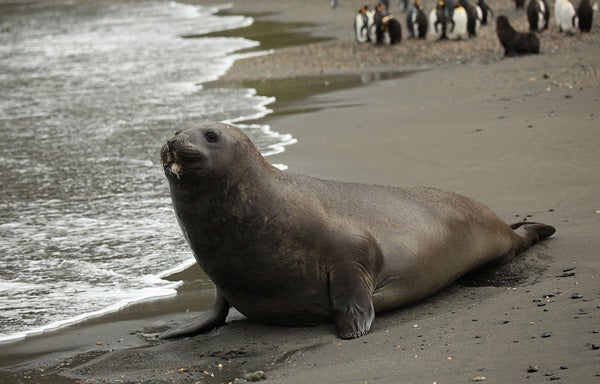
The transition to pelagic life is not easy for seals like this young Southern elephant seal. Other macrofauna provide geographical data. Credit: Liam Quinn Flickr (CC BY-SA 2.0)
The very dive-heavy lifestyle that elephant seals practise is a dangerous thing to learn. At the end of weaning, a pup has tripled in mass relative to weight at birth and has substantially increased its blood volume and muscle size; once it starts to indulge in diving behaviour, its haematocrit, haemoglobin and myoglobin concentrations increase, the result being an impressive 46% increase in oxygen storage ability. They initially dive shallow (down to 6 m or so) and do their diving at night, perhaps to avoid the predatory behaviour of white sharks.
On supporting science journalism
If you're enjoying this article, consider supporting our award-winning journalism by subscribing. By purchasing a subscription you are helping to ensure the future of impactful stories about the discoveries and ideas shaping our world today.
Data shows that yearlings struggle to put on weight, that more than half of any year’s young seals die as they fail to make a successful transition to pelagic life, and that even the successful survivors go for a while with fat reserves depleted by about 40% (Kretzmann et al. 1993, Le Boeuf et al. 1996). Young seals also tend to get lost: Northern elephant seals that breed in California migrate north, but wayward yearlings have been reported from the far western end of the Aleutian Islands, Midway (4700 km from California), Hokkaido (7800 km from California) and the Sea of Cortez (1655 km from the nearest rookery). Wow, elephant seals on Japan!
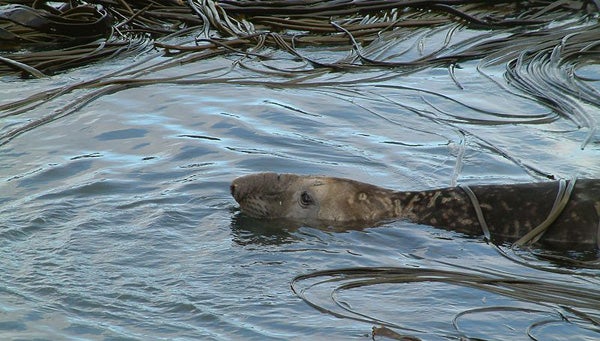
There are all too few available images of swimming elephant seals. This is a Southern elephant seal, photographed off Marion Island south of South Africa. Credit: CridF Wikimedia(CC BY-SA 4.0)
I mentioned that elephant seals dive deep, preferring or choosing to dive literally as deep as they can when leaving their rookeries and only being constrained by depth in the area (Le Boeuf & Crocker 1996). But it’s their foraging dives in the open ocean that are most spectacular. You’ve heard that sperm whales (and some beaked whales) are divers extraordinaire, sometimes diving more than 1000 m down. Less familiar is that elephant seals are amazing in the diving stakes as well, the record being a jaw-dropping 2388 m (recorded off the Western Antarctic Peninsula) (Costa et al. 2010) and a dive lasting for 120 minutes (Hindell et al. 1992). For a while, the Southern elephant seal held the deep-dive record over the sperm whale and hence over the whole of Cetacea. The record has now been broken by Cuvier’s beaked whale Ziphius cavirostris, the deepest dive of which achieved 2992 m (2992 metres), the longest for 137.5 minutes (Schorr et al. 2014).
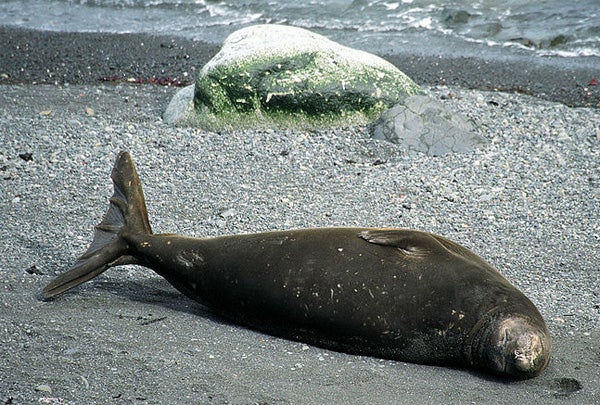
Southern elephant seal, photographed on Antarctica. I like this photo because the animal is showing off the enormous size of its webbed foot. Credit: Jerzy Strzelecki Wikimedia (CC BY-SA 3.0)
It would appear that males and females (at least among Northern elephant seals) differ in dive style, with males performing dives that have a flatter-bottomed profile than those of females. This seems to be evidence that males and females prey on different organisms – males exploiting a greater number of benthic animals – and thus that some degree of niche partitioning is present between the sexes (Le Boeuf et al. 1996).
Elephant seals and the Patagonian toothfish industry. There’s one more interesting thing to say about deep-diving behaviour in elephant seals. Today, technological advances and ever-innovative ways of exploiting marine resources mean that people are increasingly capturing deepsea animals for the food industry. And, all around the world, marine mammals are learning to exploit these practices.

Patagonian toothfish Dissostichus eleginoides, a nototheniid notothenioid. Notothenioidei = icefishes and kin, part of Perciformes in the strict sense employed by Betancur-R. et al. but also termed Serraniformes by some. Hm, I seem to know a lot about fish these days. Credit: Wikimedia
One of the best-known deepsea fisheries is that targeting Patagonian toothfish Dissostichus eleginoides in the Southern Ocean, specifically around the coasts of southern South America and the subantarctic islands. It’s been known for some time that whales – sperm whales and killer whales – target longlines set for toothfish, and have learnt to remove the fish before they’re obtained by human fishers at the surface, typically removing the fish while the lines are close to the surface and being retrieved (Purves et al. 2004)… though read on. Antarctic fur seals Arctocephalus gazella do likewise.
It’s now been learnt that Southern elephant seals are exploiting longlines too, but at least sometimes doing so at depth; that is, while the longlines are lying on the bottom during their so-called soak period (van den Hoff et al. 2017). Remote cameras reveal that the seals – which are seemingly aware of the cameras – remove virtually the whole fish, leaving only the lips. And what’s left behind – tooth-marked lips – looks similar to what’s also left behind when whales remove toothfish from longlines. It now seems possible or likely that some removal events – previously blamed on whales – might actually be the result of elephant seal behaviour. Seals in at least some areas have died after entanglement with the lines (van den Hoff et al. 2017).
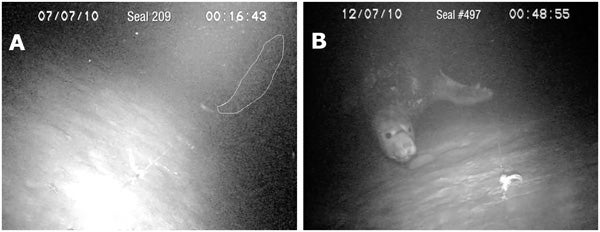
Elephant seals approaching toothfish on longlines at depth; the seal in image A is almost impossible to see (the fish is outlined in white). Images from van den Hoff et al. (2017). Credit: van den Hoff et al. 2017
Marine mammal involvement in human fishing events is an emerging area of investigation that we’re sure to hear lots about in future; let’s hope that whatever happens is not detrimental to the marine mammals.
Incidentally, the fact that elephant seal eyes are adapted for perpetual use in such dark conditions means that they may be badly affected – at least as goes eye health – when kept in captivity (and thus perpetually exposed to bright surface conditions) (Dan Garrick pers. comm.). I’ll be talking about seals in captivity in another article.
What sort of a seal is a Mirounga? Finally, what sort of seals are elephant seals, exactly? They’re clearly phocids (aka earless seals or hair seals), and they appear similar in many features to ‘monachines’, the phocid group that includes the monk seals (Monachus*) as well as the Antarctic lobodontins. A once popular idea was that elephant seals were especially close to the Hooded seal Cystophora cristata, these animals obviously sharing inflatable nasal structures and a reduced incisor count and simple post-canine teeth. However, these similarities appear convergent (King 1966), since Cystophora otherwise shares many more features with phocines (the northern seals) than it does with monachines.
* I’m ignoring the debate over the validity of Neomonachus for now (see comments).
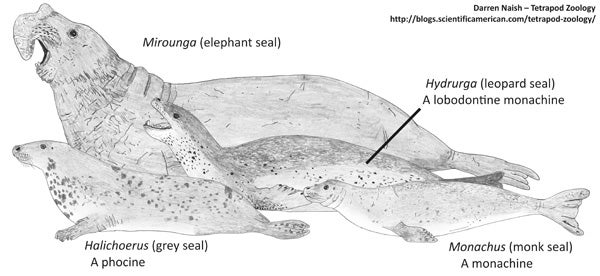
A phocid montage - a set of taxa illustrating the lineages relevant to this article. These illustrations were produced for my (still) in-prep textbook, on which go here. Credit: Darren Naish
Phylogenetic studies based on morphology variously find Monachus, Mirounga and the lobodontins successively closer to Phocinae (Wyss 1988, Bininda-Emonds & Russell 1996), or posit Mirounga to be close to lobodontins within Monachinae (de Muizon 1982, Berta et al. 2015); molecular studies support the latter topology (Fyler et al. 2005) and generally support the monophyly of Monachinae. It seems, therefore, that elephant seals evolved from a monk seal-like ancestor; exactly when and where this happened is difficult to determine. The supposedly more primitive nature of the Northern elephant seal has sometimes led to suggestions of a northern origin for Mirounga, while the apparent dominance of the Southern Hemisphere in monachine distribution overall better suggests a southern one.
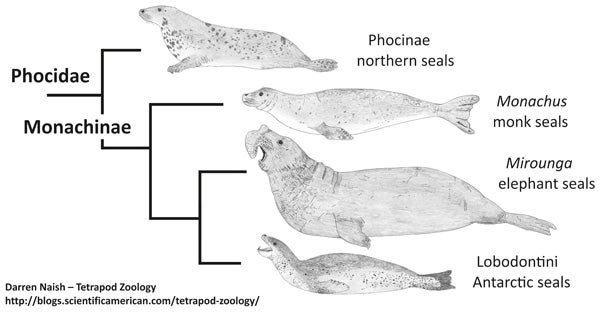
Simplified phocid cladogram depicting the lineages discussed here. Credit: Darren Naish
Fossils don’t help all that much: until recently all we had were some Pleistocene and Holocene records of Mirounga from California, Chile and South Africa. A few additional Pliocene records from South Africa and California have proved unconvincing or erroneous (Boessenecker & Churchill 2016). However, there’s now a Late Pliocene Mirounga-like seal – the ‘Waipunga seal’ – from New Zealand (Boessenecker & Churchill 2016). This seal – represented by a fragmentary skull discovered in the 1920s and as yet lacking a taxonomic name – is not especially big and was probably similar in size to a modern grey seal. This suggests that the giant size of Mirounga is a recently evolved, post-Pliocene novelty. The Waipunga seal has a bony shelf region at the front of the snout so probably had a small proboscis at least, and it also has bulbous teeth like those of Mirounga. It obviously strengthens the idea of a Southern Hemisphere origin for elephant seals.
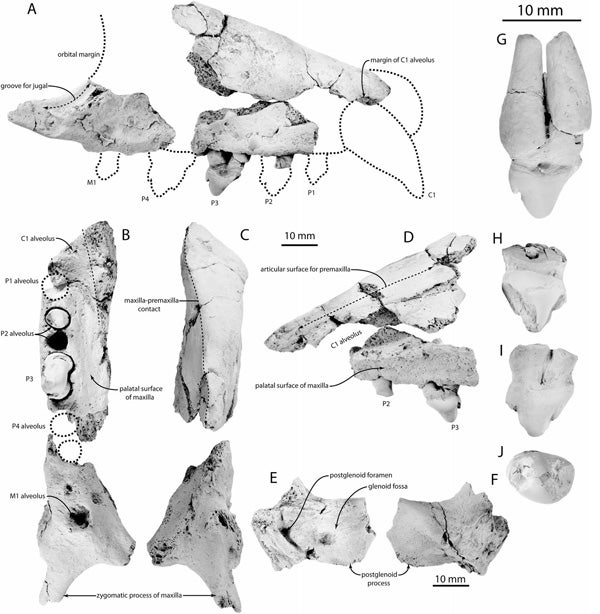
The partial skull of the Waipunga seal from the Pliocene of New Zealand, a mid-sized phocid that has key features linking it to Mirounga. Credit: Boessenecker & Churchill 2016
The only other purported fossil member of the Mirounga lineage (it’s been called Miroungini) is Callophoca from the Pliocene of Belgium and the USA. Two species have been named (C. obscura and C. ambigua); they’re said to differ primarily in size and the suggestion has been made on several occasions that they might actually represent the sexes of a single dimorphic species – an idea obviously consistent with an inferred affinity with Mirounga (de Muizon 1982). However, this inferred link is looking doubtful today since Callophoca is sufficiently nondescript to make a stem-monachine identity look more likely (Berta et al. 2015). In fact, Callophoca requires further study and there are significant doubts about its monophyly.
While there is – of course – much more to say about elephant seals (and about monachine and phocid evolution in general...), that’s where we’ll have to end for now. More on pinnipeds here very soon. For previous Tet Zoo articles on pinnipeds, see…
England ‘does a Montauk’ (mostly on the Grey seal)
Statistics, seals and sea monsters in the technical literature
Pinnipeds Descended from One Ancestral Line, Not Two (was: Seals, the Early Years)
Thanks to Bobby Boessenecker for timely assistance relevant to this article.
Refs - -
Berta, A., Kienle, S., Bianucci, G. & Sorbi, S. 2015. A re-evaluation of Pliophoca etrusca (Pinnipedia, Phocidae) from the Pliocene of Italy: phylogenetic and biogeographic implications. Journal of Vertebrate Paleontology 35: e889144
Bininda-Emonds, O. R. P. & Russell, A. P. 1996. A morphological perspective on the phylogenetic relationships of the extant phocid seals (Mammalia: Carnivora: Phocidae). Bonner Zoologische Monographien 41, 1-213.
Costa, D. P., Huckstadt, L. A., Crocker, D. E., McDonald, B. I., Goebel, M. E. & Fedak, M. A. 2010. Approaches to studying climatic change and its role on the habitat selection of Antarctic pinnipeds. Integrative and Comparative Biology 50, 1018-1030.
de Muizon, C. 1982. Phocid phylogeny and dispersal. Annals of the South African Museum 89, 175-213.
Fyler, C. A., Reeder, T. W., Antonelis, G., Aguilar, A. & Androukaki, E. 2005. Historical biogeography and phylogeny of monachine seals (Pinnipedia: Phocidae) based on mitochondrial and nuclear DNA data. Journal of Biogeography 32, 1267-1279.
Hindell, M. A., Slip, D. J., Burton, H. R. & Bryden, M. M. 1992. Physiological implications of continuous, prolonged, and deep dives of the southern elephant seal (Mirounga leonina). Canadian Journal of Zoology 70, 370-379.
King, J. E. 1966. Relationships of the hooded and elephant seals (genera Cystophora and Mirounga). Journal of Zoology 148, 385-398.
Kretzmann, M., Costa, D. P. & Le Boeuf, B. J. 1993. Maternal energy investment in elephant seal pups: evidence for sexual equality? American Naturalist 141, 466-480.
Le Boeuf, B. J. & Crocker, D. E. 1996. Diving behavior of elephant seals: implications for predator avoidance. In Klimley, A. P. & Ainley, D. G. (eds) Great White Sharks – the Biology of Carcharodon carcharias. Academic Press (London), pp. 193-205.
Le Boeuf, B. J., Morris, P. A., Blackwell, S. B., Crocker, D. E. & Costa, D. P. 1996. Diving behavior of juvenile northern elephant seals. Canadian Journal of Zoology 74, 1632-1644.
Purves, M. G., Agnew, D. J., Balguerias, E., Moreno, C. A. & Watkins, B. 2004. Killer whale (Orcinus orca) and sperm whale (Physeter macrocephalus) interactions with longline vessels in the Patagonian toothfish fishery at South Georgia, South Atlantic. CCAMLR Science 11, 111-126.
Wyss, A. R. 1988. On “retrogression” in the evolution of the Phocinae and phylogenetic affinities of the monk seals. American Museum Novitates 2924, 1-38.